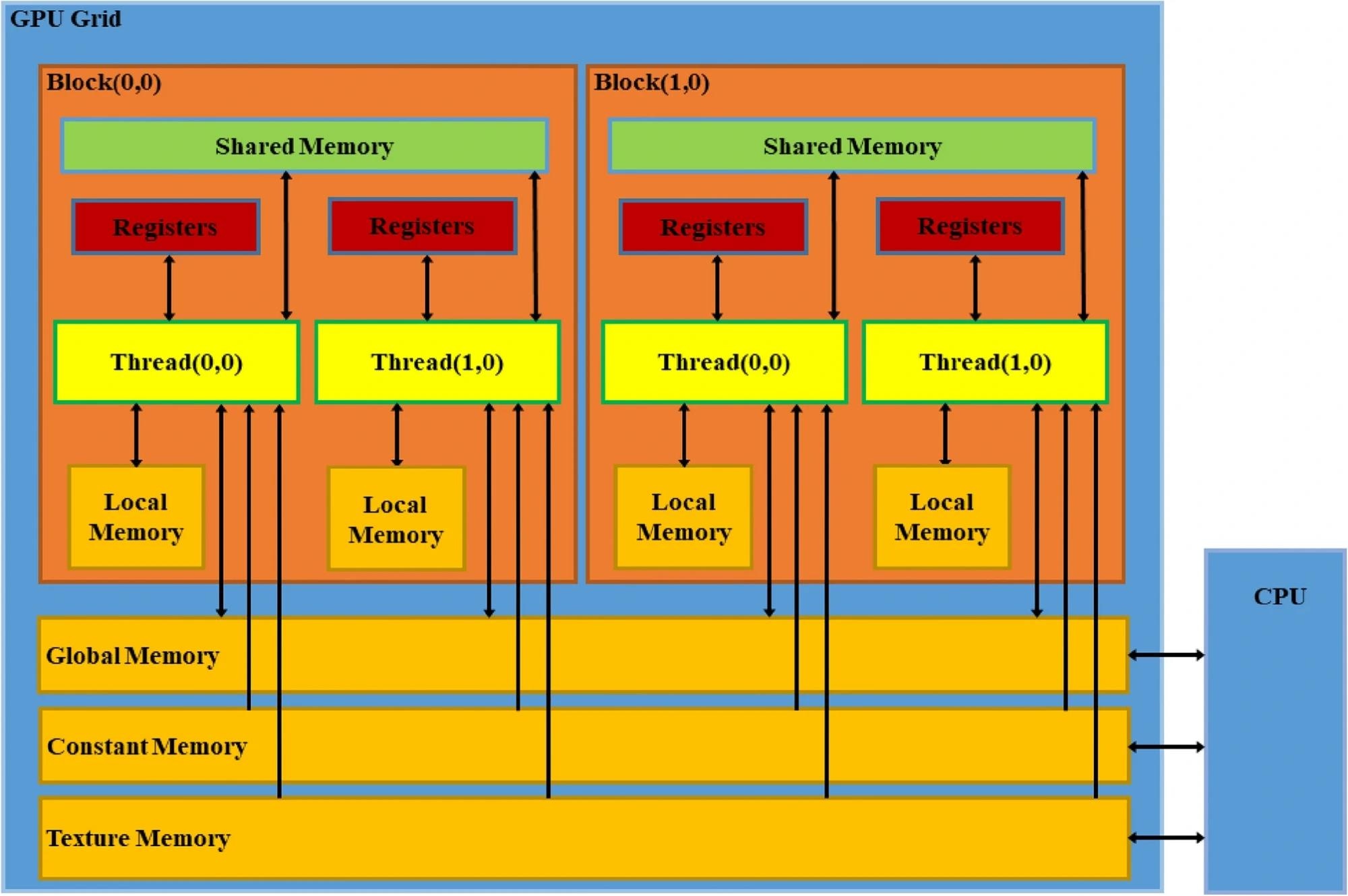In a paper published in the journal Scientific Reports, researchers tackled the global challenge of rising fine particulate matter (PM2.5) pollution from rapid industrialization and urbanization.
 CUDA memory structure. Image Credit: https://www.nature.com/articles/s41598-024-60486-9
CUDA memory structure. Image Credit: https://www.nature.com/articles/s41598-024-60486-9
They developed a novel approach, optimizing support vector regression (SVR) algorithms with compute unified device architecture (CUDA)-based code and combining them with intelligent algorithms like genetic algorithms (GA) and particle swarm optimization (PSO) to predict haze levels more accurately. Integrating these algorithms with central and graphics processing units (CPU-GPU) parallel computing, their model outperformed traditional methods, offering substantial speed improvements and enhanced reliability while maintaining high accuracy.
Related Work
Past work in haze pollution prediction has predominantly focused on leveraging advanced machine learning techniques like recurrent neural networks (RNNs), convolutional neural networks (CNNs), and deep belief networks (DBNs). While these models exhibit strong adaptability and learning capacity, they are challenged by complexities in tuning, optimization, and data quality requirements. SVR models have shown promise to address these issues due to their simplicity and robustness. However, traditional SVR needs to be improved to handle larger datasets efficiently.
Comprehensive Methodology
The approach to enhancing haze prediction accuracy is introduced by developing optimized code based on CUDA and implementing a CPU-GPU heterogeneous parallel processing architecture for the SVR model, termed CPU-GPU-SVR. This architecture distributes key computational steps of SVR across different processors for parallel execution, significantly accelerating the model's training and prediction processes.
An enhanced PSO algorithm is employed for precise parameter selection within the SVR model, further improving prediction accuracy and processing efficiency. By integrating these advancements, the team aims to introduce an efficient and accurate tool for haze prediction.
The CPU-GPU heterogeneous parallelism approach leverages CUDA, a parallel computing architecture, to exploit the computational capabilities of both CPUs and GPUs. This architecture enables collaborative computing, with CPUs handling complex logic processing and system scheduling while GPUs perform massively parallel computing.
The architecture optimizes computational workflows through efficient data transfer and shared memory utilization, particularly benefiting time series forecasting with large datasets. The integration of PSO further enhances parameter optimization, which is crucial for SVR's performance in haze prediction.
The methods also detail the implementation of the SVR algorithm using vectorization and parallel statute strategies for parallel processing. These strategies optimize computational efficiency by distributing tasks across GPU threads and leveraging shared memory for data exchange.
Additionally, the parallelization of kernel function matrices is discussed, showcasing the optimization of the most time-consuming part of the SVR algorithm. Moreover, the outline includes PSO-based optimization of CPU-GPU heterogeneous parallel SVR, offering a systematic method to determine optimal parameter values for improving prediction accuracy.
The methods section presents a comprehensive approach to improving haze prediction accuracy through optimized code development, heterogeneous parallel processing, and PSO-based parameter optimization. These advancements lay the foundation for developing a robust and efficient tool for real-time haze monitoring and rapid response measures.
Experimental Design Analysis
The experimental design of this study aims to assess the effectiveness of the proposed CPU-GPU-SVR model integrated with the PSO algorithm for predicting PM2.5 concentrations. Additionally, the research compares this model with counterparts incorporating GA and sine-cosine algorithm (SSA) algorithms, focusing on performance disparities in processing speed and accuracy.
The analysts employ standardization of population size and iteration number across all algorithms. Each model is independently run 30 times to ensure consistent evaluation. Technical specifications include using the RBF kernel function; specific parameter ranges for C and σ, and five-fold cross-validation during training.
Data preprocessing procedures involve meticulous processing of experimental datasets to evaluate the proposed model's performance and generalization ability across various data scales. Datasets sourced from the UCI machine learning database and Beijing air quality observations are processed and divided to ensure comprehensive coverage and adequate testing grounds. Data preprocessing includes handling missing values, dataset division strategies, and normalization to facilitate fair comparisons across different datasets.
The analysis of experimental results encompasses comparative evaluations of different models, focusing on metrics such as mean absolute percentage error (MAPE), root mean square error (RMSE), and R2 across 30 independent trials. Through comprehensive assessments, significant differences in prediction accuracy among models are revealed, with particular emphasis on the PSO-CPU-GPU-SVR model's exceptional performance. The study also delves into the performance of the PSO-CPU-GPU asynchronous parallel SVR model, highlighting its improved efficiency with increasing data scale and providing insights into the key parts of the algorithm's training process.
Overall, the study's experimental design, data preprocessing methodologies, and analysis of results contribute to a thorough examination of the proposed model's efficacy in haze prediction, emphasizing its predictive accuracy and computational efficiency across various scenarios.
Conclusion
To sum up, the study introduced a highly efficient PM2.5 prediction model based on a CUDA-accelerated SVR algorithm with integrated PSO optimization. This innovative approach significantly improved prediction speed and accuracy, making it suitable for large-scale environmental datasets. Comparative assessments demonstrated the superiority of the PSO-CPU-GPU-SVR model over counterparts incorporating GA and SSA algorithms.
Future research will focus on refining algorithmic fusion strategies addressing challenges associated with PSO optimization for large-scale data handling and continuously innovating to pursue advancements in data-driven environmental monitoring and examination.